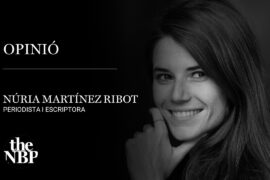Álvaro Pascual-Leone, neurologist: "We know that the brain is intrinsically...

A tree in the city is much more than ornamentation...

La universidad norteamericana publica un caso de estudio que analiza...

Barcelona has become a desired destination for investors, beyond the...

There is no need, anymore, to go to Silicon Valley...

The dFactory Incubator centre, capable of providing services simultaneously to...

The new Movistar Car service provides a Wi-Fi network in...

“Science is alive and it’s part of culture. Science is...

"Mirrors, inside and outside of reality" is one of the...

Producing and marketing homes within demand-based pricing will continue to...

Música clásica sobre la arena de la playa en dos...

The first session of the cycle on the regatta organized...

The hospital's managing director, Manel del Castillo, and the pharmaceutical...

Generalitat y Ayuntamiento impulsarán dos equipamientos de 'Casa de les...

Leticia Beleta, director of Alexion Pharmaceuticals in Spain and Portugal,...

We all have a friend who never leaves the Gràcia...

Barcelona director opts for Best International Film with 'La sociedad...

The hotel and industrial sectors softened the market's decline last...

The technology company, with a workforce of 35 employees and...

“The women of yesteryear were strong and had to fight...

One of the most memorable scenes -the centre scene, inserted in the middle of the original trilogy- explains the defeat of the Manichean paradigm of Star Wars, against simplistic opinions, who claim to see a mere fight between good and evil. We find it in The Empire Strikes Back, on the formation process of young Jedi by his master Yoda. To be specific, when he invites him to get into the cave, with no weapons: “What is in there?”, asks young Jedi. Yoda answers: “Only what you take with you”.
SINISTER PERSONALITY SPLITS
Luke disobeys his master and brings his father’s laser sword. At a point in time, appears the figure of Darth Vader, his mythical archenemy, whose lineage Luke still ignores. He immediately confronts him, and manages, almost effortlessly, to behead him. The truly sinister appearance, however, is another one: under the mask of an agent of evil, what Luke sees, his face coming out of a robot torso, is an image of himself.
The filmmaker who pioneered the use of the most sinister possibilities of cyber virtuality was Fritz Lang, when creating Metròpolis (1927) the first replicant, the evil double of someone -called Maria- previously characterized by her gentle behaviour. The two extremes -selfishness, immediate and personal interest vs. selflessness and self-sacrifice for the sake of others -, are represented by the same actress, to the protagonist’s bewilderment, who ignores, in Lang’s plot, the artifice of reduplication enabled by robotic engineering. The feeling of dizziness on seeing (who she believes is) her Maria in poorly dignified behaviours, when this is actually the robot, is comparable to experiencing “the sinister”, which Freud had identified in E.T.A. Hoffmann’s most celebrated narration, The Sandman (1816).
Like in Metropolis, it presents the unbearable reality of one’s beloved who, somehow, is not: despite the appearance, she does not exist because this is an automaton, a beautiful mechanical monstrosity, built by an individual linked, in turn, to the death of the protagonist’s father. The female splits, that turn women into almost unreachable beings, do not belong only to Romantic and post-Romantic imagination. Let us consider, for example, Ese oscuro objeto del deseo dby Luis Buñuel, where two actresses represent the same and unfathomable woman. More recently, in Lost highway, David Lynch reuses the splitting of the outstanding Vertigo, by Alfred Hitchcock, by using the same actress for two dissimilar personalities with common traits: they are both attractive and elusive.
Back to the sinister appearance of Vader in The Empire Strikes Back, it is worth saying that the other -the most different and hated- appears to be familiar, as a counter-image of oneself, made through an emotional link. This image may not be, in fact, “real”; but if it has an effect is because it could be. Coincidentia oppositorum, said the ancient, anticipates -in that scene- reality. Therefore, Darth Vader is actually Luke, somehow the latter is (the product of) the former. To be specific, it can be stated that Luke assimilates Vader by the way he attacks him, driven by fear and moved by hate.
The other -the most different and hated- appears to be familiar, as a counter- image of oneself, made through an emotional link
The need to dilucidate her family fate is the same that drives Rey, in The last Jedi, into a sinister cave, in the depths of the sacred island. Once there, she looks for answers, lured by the matrixial darkness of her vital question: can she know who she is, if she does not know who her parents were? In this earthy experience, that inevitably recalls that of the young Skywalker, she cannot find a solution, but she does, instead, a multiplication of her own image, serially reproduced, that leads her to the end, a crystal that defrosts, behind which she expects to see her parents. The spectator accompanies her in her eagerness to discover the truth: what she sees is her own face looking for herself, reflected on the gaze that aims to repair the damage inflicted onto her.
“WHAT SHOULD I DO, MASTER?”
Love and hate, as long as they are driving feelings, claim each other as the most powerful across the saga, also in the battle between the Jedi against their own interests. Experiencing the outburst of fury of martial action leads to the dark side. Lack of interest is required in the most instinctive of actions, self-preservation in the face of one’s enemy, the supreme paradox that engages the spectator’s attention. “If you strike me down, I will always be around to haunt you”, warns Luke to Kylo Ren. This is a similar message from Obi-Wan to Vader, before disappearing, in Star Wars (Episode I, also called A New Hope): “if you strike me down, I shall become more powerful than you can possibly imagine”.
Preventing the reactive form of nihilism is the underlying purpose behind Nietzsche’s warning in Twilight of the Idols: this consists in bringing down fallacious ideals -empty images, previously worshipped- without anger or resentment, as a game, to avoid being trapped by a relationship of domination exerted, paradoxically, by what one wants to eliminate. From a bluntly Buddhist perspective, less aggressive on its approaches, the Jedi is required, by moral imperative, a certain detachment and entire concentration on the moment, two of the less frequent attitudes of our times. Possibly, this may be the reason why they are so appreciated on screen, understood as typical of heroes, like enabling a space to live a second reality that complements the one lived on an immediate basis.
The Jedi is required, by moral imperative, a certain detachment and entire concentration on the moment, two of the less frequent attitudes of our times
It is worth noting that Anakin Skywalker in love, trapped in his own anguish (caused by recurrent admonitions that, when dreaming, make him fear the death of his pregnant wife) had asked Yoda, as if he were the oracle: “What should I do?”. The reply of the master Jedi is clear as well as difficult to implement in practice, from Skywalker’s perspective: “Train yourself to let go everything you fear to lose”.
This let go, in relation to what one most desires to own, is unnatural and contrary to common sense, and can be likened to the movement of faith illustrated by Abraham, the Old Testament’s patriarch who accepts to sacrifice his son Isaac, after many years (decades) waiting for him.
Søren Kierkegaard exploited extensively the Biblical excerpt Fear and Trembling to point critically to the inadequacy of rational thinking when it comes to understanding and communicating the spiritual fate of man, in his relationship with the transcendent dimension. Its favourite alternative -the concept of faith from the absurd, as a movement that defies and avoids theories- finds its place on radicalization of a certain Lutheran cosmovision, closely and surreptitiously near the Nietzschean outbreak, which maintains with the pacifist version of Buddhism some sort of parallelism. Rudolf Otto, in an article on the experience of the numinous in zazen, Das Numinose Erlebnis im Zazen, makes some shocking statements about the masters, like, “when they say that they do not want to know or hear anything about Buddha or even zen. When you become conscious of these things -he adds- is because they are not owned in their original and real form”.
THE END (BEYOND APPEARANCE)
In this final paragraph, let us go back to square one. Specifically, to Yoda’s paradoxical statement in The Last Jedi (Episode VIII), that in times of massive coaching we may be closer to fully understand: “The greatest teacher, failure is”. This quote holds some relationship with the problem also spotted by Luke Skywalker, this deification of sorts implicit in the fact of “being a legend”, of being considered, from the concept of myth, an excessively self-indulgent image of oneself.
Putting an end to the Jedi discipline as a myth is the condition whereby, in the gatopardian changing-things-so-everything-stays-the-same spirit, its own raison d’etre is then updated. Ambiguity is incessant in The Last Jedi: one scrap of hope is hinted at in the corrupted Kylo Ren, and Luke’s confirmation of his own fallibility. The decision to destroy the temple and the sacred texts -shared by Yoda and Luke- aims to resume a new stock of heroes, while questioning the unconditional value of the legend, and recalls, in a critical tone, the human (and yet irrational) need to believe.
Putting an end to the Jedi discipline as a myth is the condition whereby, in the gatopardian changing-things-so-everything-stays-the-same spirit, its own raison d’etre is then updated
Yoda’s statement, in line with the ongoing inner crisis of the still “young Skywalker” -so does his teacher refer to him as- reveals the frailty of the feeling that comes with victory. It joins the critical opinion of the relationship between dependence that generates belief, as well as the purely theoretical assimilation, and the claimed possession of things or people. These forms of apprehension activate corruption, pave the way for the dark side of the Force. Also from another teacher, Mace Windu, young Anakin, had received -in vain- a very specific warning (“Be mindful of your feelings”), as an invitation to identify his own inner determining factors, with a view to transcending them and avoiding falling prey on them.
The thinking of Buddhist influence are revealed quite openly in the Jedi discipline, and Rey’s training in The Last Jedi emphasizes this correlation, never completely mutually exclusive, between good and evil, which transcends the apparent Manicheism of the narrative proposal. The “dark side” of the Force does not have an entity, may be interpreted as negative, even with Saint Augustine, as corruption or absence of Good; nor is the positive side something that could be possessed, just like that, and brandish as a privilege, merely because of one’s status as a Jedi.
Yoda, always charismatic, represents the zen master, and therefore postulates detachment, shedding all interest and passion as a way to achieve full attention, to concentrate on a moment in life and to eliminate all fear, which, in turn, blurs any possibility of suffering. The term for this type of conscience is mindfulness, a term linked to the practice of meditation, which Luke exploits down to the last consequences –spoiler alert!-, also thanks to the magic of cinema fiction at the very end of The Last Jedi. The power of the mind is used to confuse the enemy, thus recreating, at a distance, a false image of oneself, an (unreal) appearance forged from full concentration, leaving aside the ups and downs of emotions. Luke appears and disappears. He is the one who channels and condenses Kylo Ren’s hate, the thirst for self-assertiveness after destruction, into what he inevitably must stop being.
Offering, from another location, another model of behaviour, with a happy end -“happy” as a rebirth, beyond time-, authenticates the religious function of the myth
From a distance, Luke vanishes and drops his outfits, just like Obi-Wan Kenobi had. Likewise, the apparent eradication, under the influence of hate, eternalizes its spiritual reality, both for the enemy and the generations of disciples and fans. The translucent reappearances will be ghostly or threatening for some, but heavenly for others; for those who believe or want to believe from fiction, in this time of crisis. And so, Luke will meet Yoda or Obi-Wan himself, as an immortal being who advises and guides the living. Offering, from another location, another model of behaviour, with a happy end -“happy” as a rebirth, beyond time-, authenticates the religious function of the myth. (The end of the trilogy).

One of the most memorable scenes -the centre scene, inserted in the middle of the original trilogy- explains the defeat of the Manichean paradigm of Star Wars, against simplistic opinions, who claim to see a mere fight between good and evil. We find it in The Empire Strikes Back, on the formation process of young Jedi by his master Yoda. To be specific, when he invites him to get into the cave, with no weapons: “What is in there?”, asks young Jedi. Yoda answers: “Only what you take with you”.
SINISTER PERSONALITY SPLITS
Luke disobeys his master and brings his father’s laser sword. At a point in time, appears the figure of Darth Vader, his mythical archenemy, whose lineage Luke still ignores. He immediately confronts him, and manages, almost effortlessly, to behead him. The truly sinister appearance, however, is another one: under the mask of an agent of evil, what Luke sees, his face coming out of a robot torso, is an image of himself.
The filmmaker who pioneered the use of the most sinister possibilities of cyber virtuality was Fritz Lang, when creating Metròpolis (1927) the first replicant, the evil double of someone -called Maria- previously characterized by her gentle behaviour. The two extremes -selfishness, immediate and personal interest vs. selflessness and self-sacrifice for the sake of others -, are represented by the same actress, to the protagonist’s bewilderment, who ignores, in Lang’s plot, the artifice of reduplication enabled by robotic engineering. The feeling of dizziness on seeing (who she believes is) her Maria in poorly dignified behaviours, when this is actually the robot, is comparable to experiencing “the sinister”, which Freud had identified in E.T.A. Hoffmann’s most celebrated narration, The Sandman (1816).
Like in Metropolis, it presents the unbearable reality of one’s beloved who, somehow, is not: despite the appearance, she does not exist because this is an automaton, a beautiful mechanical monstrosity, built by an individual linked, in turn, to the death of the protagonist’s father. The female splits, that turn women into almost unreachable beings, do not belong only to Romantic and post-Romantic imagination. Let us consider, for example, Ese oscuro objeto del deseo dby Luis Buñuel, where two actresses represent the same and unfathomable woman. More recently, in Lost highway, David Lynch reuses the splitting of the outstanding Vertigo, by Alfred Hitchcock, by using the same actress for two dissimilar personalities with common traits: they are both attractive and elusive.
Back to the sinister appearance of Vader in The Empire Strikes Back, it is worth saying that the other -the most different and hated- appears to be familiar, as a counter-image of oneself, made through an emotional link. This image may not be, in fact, “real”; but if it has an effect is because it could be. Coincidentia oppositorum, said the ancient, anticipates -in that scene- reality. Therefore, Darth Vader is actually Luke, somehow the latter is (the product of) the former. To be specific, it can be stated that Luke assimilates Vader by the way he attacks him, driven by fear and moved by hate.
The other -the most different and hated- appears to be familiar, as a counter- image of oneself, made through an emotional link
The need to dilucidate her family fate is the same that drives Rey, in The last Jedi, into a sinister cave, in the depths of the sacred island. Once there, she looks for answers, lured by the matrixial darkness of her vital question: can she know who she is, if she does not know who her parents were? In this earthy experience, that inevitably recalls that of the young Skywalker, she cannot find a solution, but she does, instead, a multiplication of her own image, serially reproduced, that leads her to the end, a crystal that defrosts, behind which she expects to see her parents. The spectator accompanies her in her eagerness to discover the truth: what she sees is her own face looking for herself, reflected on the gaze that aims to repair the damage inflicted onto her.
“WHAT SHOULD I DO, MASTER?”
Love and hate, as long as they are driving feelings, claim each other as the most powerful across the saga, also in the battle between the Jedi against their own interests. Experiencing the outburst of fury of martial action leads to the dark side. Lack of interest is required in the most instinctive of actions, self-preservation in the face of one’s enemy, the supreme paradox that engages the spectator’s attention. “If you strike me down, I will always be around to haunt you”, warns Luke to Kylo Ren. This is a similar message from Obi-Wan to Vader, before disappearing, in Star Wars (Episode I, also called A New Hope): “if you strike me down, I shall become more powerful than you can possibly imagine”.
Preventing the reactive form of nihilism is the underlying purpose behind Nietzsche’s warning in Twilight of the Idols: this consists in bringing down fallacious ideals -empty images, previously worshipped- without anger or resentment, as a game, to avoid being trapped by a relationship of domination exerted, paradoxically, by what one wants to eliminate. From a bluntly Buddhist perspective, less aggressive on its approaches, the Jedi is required, by moral imperative, a certain detachment and entire concentration on the moment, two of the less frequent attitudes of our times. Possibly, this may be the reason why they are so appreciated on screen, understood as typical of heroes, like enabling a space to live a second reality that complements the one lived on an immediate basis.
The Jedi is required, by moral imperative, a certain detachment and entire concentration on the moment, two of the less frequent attitudes of our times
It is worth noting that Anakin Skywalker in love, trapped in his own anguish (caused by recurrent admonitions that, when dreaming, make him fear the death of his pregnant wife) had asked Yoda, as if he were the oracle: “What should I do?”. The reply of the master Jedi is clear as well as difficult to implement in practice, from Skywalker’s perspective: “Train yourself to let go everything you fear to lose”.
This let go, in relation to what one most desires to own, is unnatural and contrary to common sense, and can be likened to the movement of faith illustrated by Abraham, the Old Testament’s patriarch who accepts to sacrifice his son Isaac, after many years (decades) waiting for him.
Søren Kierkegaard exploited extensively the Biblical excerpt Fear and Trembling to point critically to the inadequacy of rational thinking when it comes to understanding and communicating the spiritual fate of man, in his relationship with the transcendent dimension. Its favourite alternative -the concept of faith from the absurd, as a movement that defies and avoids theories- finds its place on radicalization of a certain Lutheran cosmovision, closely and surreptitiously near the Nietzschean outbreak, which maintains with the pacifist version of Buddhism some sort of parallelism. Rudolf Otto, in an article on the experience of the numinous in zazen, Das Numinose Erlebnis im Zazen, makes some shocking statements about the masters, like, “when they say that they do not want to know or hear anything about Buddha or even zen. When you become conscious of these things -he adds- is because they are not owned in their original and real form”.
THE END (BEYOND APPEARANCE)
In this final paragraph, let us go back to square one. Specifically, to Yoda’s paradoxical statement in The Last Jedi (Episode VIII), that in times of massive coaching we may be closer to fully understand: “The greatest teacher, failure is”. This quote holds some relationship with the problem also spotted by Luke Skywalker, this deification of sorts implicit in the fact of “being a legend”, of being considered, from the concept of myth, an excessively self-indulgent image of oneself.
Putting an end to the Jedi discipline as a myth is the condition whereby, in the gatopardian changing-things-so-everything-stays-the-same spirit, its own raison d’etre is then updated. Ambiguity is incessant in The Last Jedi: one scrap of hope is hinted at in the corrupted Kylo Ren, and Luke’s confirmation of his own fallibility. The decision to destroy the temple and the sacred texts -shared by Yoda and Luke- aims to resume a new stock of heroes, while questioning the unconditional value of the legend, and recalls, in a critical tone, the human (and yet irrational) need to believe.
Putting an end to the Jedi discipline as a myth is the condition whereby, in the gatopardian changing-things-so-everything-stays-the-same spirit, its own raison d’etre is then updated
Yoda’s statement, in line with the ongoing inner crisis of the still “young Skywalker” -so does his teacher refer to him as- reveals the frailty of the feeling that comes with victory. It joins the critical opinion of the relationship between dependence that generates belief, as well as the purely theoretical assimilation, and the claimed possession of things or people. These forms of apprehension activate corruption, pave the way for the dark side of the Force. Also from another teacher, Mace Windu, young Anakin, had received -in vain- a very specific warning (“Be mindful of your feelings”), as an invitation to identify his own inner determining factors, with a view to transcending them and avoiding falling prey on them.
The thinking of Buddhist influence are revealed quite openly in the Jedi discipline, and Rey’s training in The Last Jedi emphasizes this correlation, never completely mutually exclusive, between good and evil, which transcends the apparent Manicheism of the narrative proposal. The “dark side” of the Force does not have an entity, may be interpreted as negative, even with Saint Augustine, as corruption or absence of Good; nor is the positive side something that could be possessed, just like that, and brandish as a privilege, merely because of one’s status as a Jedi.
Yoda, always charismatic, represents the zen master, and therefore postulates detachment, shedding all interest and passion as a way to achieve full attention, to concentrate on a moment in life and to eliminate all fear, which, in turn, blurs any possibility of suffering. The term for this type of conscience is mindfulness, a term linked to the practice of meditation, which Luke exploits down to the last consequences –spoiler alert!-, also thanks to the magic of cinema fiction at the very end of The Last Jedi. The power of the mind is used to confuse the enemy, thus recreating, at a distance, a false image of oneself, an (unreal) appearance forged from full concentration, leaving aside the ups and downs of emotions. Luke appears and disappears. He is the one who channels and condenses Kylo Ren’s hate, the thirst for self-assertiveness after destruction, into what he inevitably must stop being.
Offering, from another location, another model of behaviour, with a happy end -“happy” as a rebirth, beyond time-, authenticates the religious function of the myth
From a distance, Luke vanishes and drops his outfits, just like Obi-Wan Kenobi had. Likewise, the apparent eradication, under the influence of hate, eternalizes its spiritual reality, both for the enemy and the generations of disciples and fans. The translucent reappearances will be ghostly or threatening for some, but heavenly for others; for those who believe or want to believe from fiction, in this time of crisis. And so, Luke will meet Yoda or Obi-Wan himself, as an immortal being who advises and guides the living. Offering, from another location, another model of behaviour, with a happy end -“happy” as a rebirth, beyond time-, authenticates the religious function of the myth. (The end of the trilogy).
